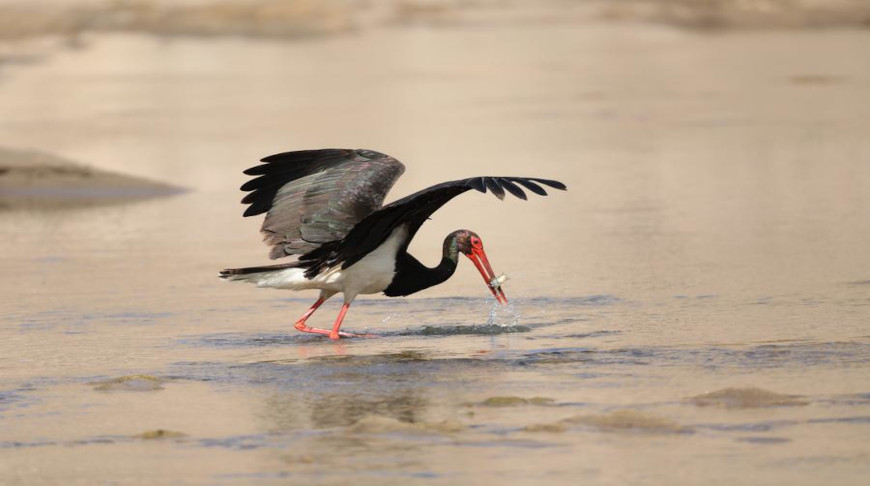
LANZHOU, 23 July (BelTA - Xinhua) - With the implementation of enhanced
ecological conservation measures, the Heihe Wetland National Nature
Reserve in northwest China's Gansu Province, is experiencing a
remarkable boom in migratory bird populations, particularly the
endangered black stork.
The latest data from the reserve's management bureau reveals that 82 black stork nests have been spotted in Zhangye City, 32 of which are active breeding nests. This year has seen a successful fledging of 27 young black storks, an increase of four nests from the previous year.
"The black stork is incredibly selective when it comes to its habitat, especially its foraging waters," said Shan Guofeng, a dedicated official from the nature reserve's management bureau. "Their stable breeding in the Heihe wetland is a testament to the positive impact of our environmental efforts. It's rewarding to see our hard work bearing fruit."
The reserve on the Central Asian migratory route plays a pivotal role as a stopover and resting place, and is one of China's three major bird migration corridors. It is home to a significant population of both breeding and migratory black storks, making it an ideal spot for research into their breeding and habitat.
Committed to a deeper understanding of the black stork's breeding habits and migration patterns, Shan and his team have been conducting meticulous monitoring since 2021. Their daily routine involves walking an average of 15 km, spending 10 hours in observation, and meticulously documenting observation logs, with a total of more than 10,000 photographs taken so far.
"Black storks start mating and breeding in early March, lay eggs by the end of the same month, and the incubation period lasts for approximately 35 days," Shan explained, recalling a record observation of 627 black storks in a single session.
Ongoing observations by Shan's team have highlighted a decrease in the feeding frequency of black storks during the low water season of the local Heihe River. They have integrated food supply enhancement into their daily operations, alongside other protective initiatives such as wetland restoration and enhanced monitoring, aiming to help restore the species' population.
This year, Shan and his team are embarking on a project to establish a specialized feeding area for the black storks. "Given their high alertness, we need to take into account all aspects, including shallow water zones and biological isolation areas. A comfortable environment with abundant food is crucial for their breeding success," Shan added.
By the end of last year, the variety of bird species in the wetland reserve had expanded to 241, representing a significant increase of 86 species recorded since the reserve's inception.
As the number of migratory birds stopping over in Zhangye increases, Shen Yang, a 54-year-old line patroller from the Zhangye branch of the State Grid Gansu Electric Power Company, finds himself increasingly occupied.
Shen, who has a lifelong passion for birds, now also assists in building artificial bird nests and innovative bird deterrents, monitoring and promptly relocating bird nests that pose safety hazards, thus safeguarding the migratory birds' journey.
"During spring and autumn, migratory birds are accustomed to nesting and breeding on the poles and towers of power lines. Such activities can easily lead to power outages and endanger their own survival," Shen explained.
In recent years, to better protect both the birds and the power infrastructure, the Zhangye branch of the State Grid Gansu Electric Power Company has initiated building safer homes for the birds. So far, Shen and his colleagues have built 140 artificial bird nests, and installed over 200 eco-friendly audiovisual bird deterrents and more than 20,000 bird spikes in areas frequented by nesting birds.
"With the growing number of migratory birds, we are determined to protect them through our efforts and foster a harmonious coexistence between man and nature," said Feng Haibo, an administrative staffer of the State Grid Gansu Electric Power Company's Zhangye branch.
The latest data from the reserve's management bureau reveals that 82 black stork nests have been spotted in Zhangye City, 32 of which are active breeding nests. This year has seen a successful fledging of 27 young black storks, an increase of four nests from the previous year.
"The black stork is incredibly selective when it comes to its habitat, especially its foraging waters," said Shan Guofeng, a dedicated official from the nature reserve's management bureau. "Their stable breeding in the Heihe wetland is a testament to the positive impact of our environmental efforts. It's rewarding to see our hard work bearing fruit."
The reserve on the Central Asian migratory route plays a pivotal role as a stopover and resting place, and is one of China's three major bird migration corridors. It is home to a significant population of both breeding and migratory black storks, making it an ideal spot for research into their breeding and habitat.
Committed to a deeper understanding of the black stork's breeding habits and migration patterns, Shan and his team have been conducting meticulous monitoring since 2021. Their daily routine involves walking an average of 15 km, spending 10 hours in observation, and meticulously documenting observation logs, with a total of more than 10,000 photographs taken so far.
"Black storks start mating and breeding in early March, lay eggs by the end of the same month, and the incubation period lasts for approximately 35 days," Shan explained, recalling a record observation of 627 black storks in a single session.
Ongoing observations by Shan's team have highlighted a decrease in the feeding frequency of black storks during the low water season of the local Heihe River. They have integrated food supply enhancement into their daily operations, alongside other protective initiatives such as wetland restoration and enhanced monitoring, aiming to help restore the species' population.
This year, Shan and his team are embarking on a project to establish a specialized feeding area for the black storks. "Given their high alertness, we need to take into account all aspects, including shallow water zones and biological isolation areas. A comfortable environment with abundant food is crucial for their breeding success," Shan added.
By the end of last year, the variety of bird species in the wetland reserve had expanded to 241, representing a significant increase of 86 species recorded since the reserve's inception.
As the number of migratory birds stopping over in Zhangye increases, Shen Yang, a 54-year-old line patroller from the Zhangye branch of the State Grid Gansu Electric Power Company, finds himself increasingly occupied.
Shen, who has a lifelong passion for birds, now also assists in building artificial bird nests and innovative bird deterrents, monitoring and promptly relocating bird nests that pose safety hazards, thus safeguarding the migratory birds' journey.
"During spring and autumn, migratory birds are accustomed to nesting and breeding on the poles and towers of power lines. Such activities can easily lead to power outages and endanger their own survival," Shen explained.
In recent years, to better protect both the birds and the power infrastructure, the Zhangye branch of the State Grid Gansu Electric Power Company has initiated building safer homes for the birds. So far, Shen and his colleagues have built 140 artificial bird nests, and installed over 200 eco-friendly audiovisual bird deterrents and more than 20,000 bird spikes in areas frequented by nesting birds.
"With the growing number of migratory birds, we are determined to protect them through our efforts and foster a harmonious coexistence between man and nature," said Feng Haibo, an administrative staffer of the State Grid Gansu Electric Power Company's Zhangye branch.













